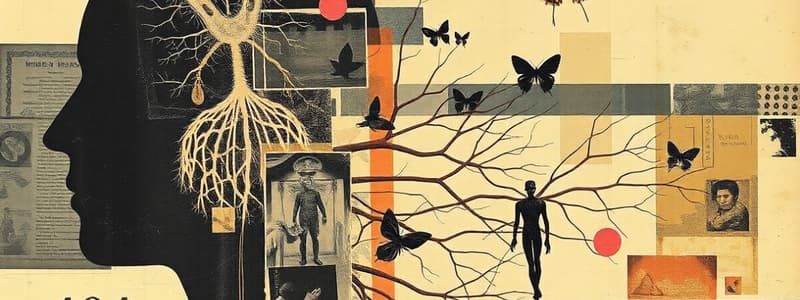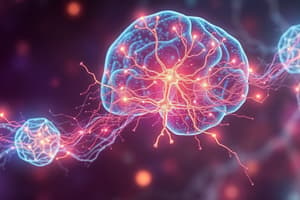Podcast
Questions and Answers
Which of the following substances is classified as a sympathetic neurotransmitter?
Which of the following substances is classified as a sympathetic neurotransmitter?
- Dopamine
- Acetylcholine
- Sympathin (correct)
- Muscarine
What key concept did Dixon propose regarding the vagus nerve in 1907?
What key concept did Dixon propose regarding the vagus nerve in 1907?
- It acts solely as an inhibitor of nerve impulses.
- It primarily affects the sympathetic nervous system.
- It liberated a muscarine-like chemical. (correct)
- It released a substance acting as a stimulant.
What did Barger and Dale identify about the effects of sympathetic nerve stimulation?
What did Barger and Dale identify about the effects of sympathetic nerve stimulation?
- They primarily depend on the presence of sympathin.
- They lack similarity with any known chemical substances.
- They resemble the effects of sympathomimetic primary amines. (correct)
- They are most closely reproduced by secondary amines.
In the context of neurotransmitters, which of the following actions was NOT noted by Dale regarding acetylcholine?
In the context of neurotransmitters, which of the following actions was NOT noted by Dale regarding acetylcholine?
What did Reid Hunt investigate in 1910 regarding neurotransmitters?
What did Reid Hunt investigate in 1910 regarding neurotransmitters?
Which mechanism is primarily responsible for the action of antiepileptic drugs?
Which mechanism is primarily responsible for the action of antiepileptic drugs?
What is a common side effect associated with benzodiazepines?
What is a common side effect associated with benzodiazepines?
Which class of antidepressants primarily works by inhibiting the reuptake of serotonin?
Which class of antidepressants primarily works by inhibiting the reuptake of serotonin?
Which condition is a contraindication for benzodiazepine usage?
Which condition is a contraindication for benzodiazepine usage?
What is a potential risk associated with the long-term use of antiepileptic drugs?
What is a potential risk associated with the long-term use of antiepileptic drugs?
Which neurotransmitter's activity is primarily targeted by the pharmacotherapy of anxiety disorders?
Which neurotransmitter's activity is primarily targeted by the pharmacotherapy of anxiety disorders?
Which of the following best describes a common action of mood stabilizers in bipolar disorder treatment?
Which of the following best describes a common action of mood stabilizers in bipolar disorder treatment?
What is a notable withdrawal symptom associated with benzodiazepines?
What is a notable withdrawal symptom associated with benzodiazepines?
Which neurotransmitter is primarily associated with the action of benzodiazepines?
Which neurotransmitter is primarily associated with the action of benzodiazepines?
What is the primary mechanism of action for most anti-depressants?
What is the primary mechanism of action for most anti-depressants?
Which of the following divisions of the autonomic nervous system is activated during a stress response?
Which of the following divisions of the autonomic nervous system is activated during a stress response?
5-HT, a neurotransmitter involved in mood regulation, is also known as what?
5-HT, a neurotransmitter involved in mood regulation, is also known as what?
Which type of receptor is predominantly involved in the actions of anti-epileptics?
Which type of receptor is predominantly involved in the actions of anti-epileptics?
Which cranial nerve is part of the parasympathetic division responsible for innervating the heart?
Which cranial nerve is part of the parasympathetic division responsible for innervating the heart?
What role does inositol 1,4,5-trisphosphate (IP3) play in neurotransmitter signaling?
What role does inositol 1,4,5-trisphosphate (IP3) play in neurotransmitter signaling?
Which condition is commonly treated with benzodiazepines due to their sedative properties?
Which condition is commonly treated with benzodiazepines due to their sedative properties?
Which of the following terms refers to the inhibitory postsynaptic potential?
Which of the following terms refers to the inhibitory postsynaptic potential?
Which of the following neurotransmitters is primarily associated with the sympathetic functions integrated by the midline nuclei?
Which of the following neurotransmitters is primarily associated with the sympathetic functions integrated by the midline nuclei?
What role do interstitial cells of Cajal (ICC) play in the enteric nervous system?
What role do interstitial cells of Cajal (ICC) play in the enteric nervous system?
At which level are higher integrated patterns of response generally organized?
At which level are higher integrated patterns of response generally organized?
Which of the following is NOT a characteristic of the extraneuronal transporter (ENT)?
Which of the following is NOT a characteristic of the extraneuronal transporter (ENT)?
What is the primary function of excitatory postsynaptic potentials (EPSP) within the central nervous system?
What is the primary function of excitatory postsynaptic potentials (EPSP) within the central nervous system?
What is the role of the tuber cinereum in autonomic function?
What is the role of the tuber cinereum in autonomic function?
Which component is least likely to be directly involved in the patterned responses organized by the brainstem?
Which component is least likely to be directly involved in the patterned responses organized by the brainstem?
In which context would dihydroxyphenylglycolaldehyde (DOPGAL) likely be significant?
In which context would dihydroxyphenylglycolaldehyde (DOPGAL) likely be significant?
Which level of the nervous system is involved in organizing more limited responses as compared to the hypothalamic level?
Which level of the nervous system is involved in organizing more limited responses as compared to the hypothalamic level?
Which neurotransmitter could potentially influence both autonomic and behavioral responses through its integration at the hypothalamic level?
Which neurotransmitter could potentially influence both autonomic and behavioral responses through its integration at the hypothalamic level?
Study Notes
Neurotransmission: Autonomic and Somatic Motor Systems
- Autonomic nervous system has two main divisions: sympathetic (thoracic and lumbar regions) and parasympathetic (cranial nerves III, VII, IX, X, and sacral regions).
- Effector cells have both excitatory and inhibitory "receptive substances".
- Epinephrine (EPI) is a chemical mediator released by sympathetic nerves at neuroeffector junctions.
- Early studies suggested "sympathin" is similar to EPI but not identical.
- ACh (acetylcholine) and choline esters were identified as chemical transmitters, with actions mimicking muscarinic and nicotinic responses.
- Neurotransmission involves integration at hypothalamic, basal forebrain, brainstem, and spinal cord levels.
- Integrated responses involve autonomic, endocrine, and behavioral components.
Studying That Suits You
Use AI to generate personalized quizzes and flashcards to suit your learning preferences.




